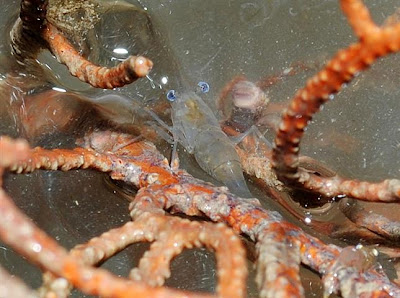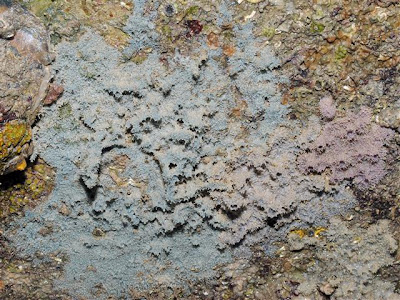I'm back at the shores of East Coast Park to check out other stretches of this long reclaimed beach!
And I'm glad to see that many of these colourful sea fans are still doing well outside this seawall. They sure are crowded!
Documenting these Sea fans or Gorgonians (Order Gorgonacea) are not easy and it requires super low tides that occur only in a few days of the year. Of course, there are many splashes from the waves that made the attempt more wet haha.
Here's a look at the more common red-version of the sea fans found at this stretch. They are larger than the usual colonies that we find at Changi and other parts of East Coast.
Also found outside the seawall is this brown version that looks like a tree that branches out to many parts.
As usual, there are lots of life that is associated with the sea fans. Today, I saw this shrimp taking shelter among the branches of this sea fan. Not too sure if it is exactly a commensal.
Similar to yesterday's trip, we found Basket stars (Family Euryalidae) on the branches of the sea fans! Here is a look at both the front and underside of this special echinoderm.
Later on, Ron found yet another basket star! The basket stars cling on tenaciously onto the sea fan amidst the strong crashing waves.
On the rockier parts, we saw this basket star that looks a little different from those we have been finding. is slightly orangey or beige and I have seen it at Sister's Island and Pulau Hantu.
Many of these Spindle or False cowrie snails (Family Ovulidae) can be found on the sea fans and since their colour is similar to the gorgonian, they are pretty well camouflaged! It takes a little more effort to identify them.
This spindle cowrie is yet another type that is larger than the usual ones and has a pretty mantle that covers over the shell. You can also see the red foot with white edges clearly in this photo.
Other commensals of the sea fans include the Winged oysters (Family Pteriidae) and the Tiny colourful brittle stars (Ophiothela danae).
A few of the Feather stars (Order Comatulida) were found and this small individual has something living with it!
It is a commensal brittle star! This brittle star has a black body with white spots. Ron also found another feather star with a white commensal brittle star (also found yesterday), which I missed it again.
There are some juvenile growths of Disk corals (Turbinaria sp.) growing on the rocks outside the seawall. This is a good sign of settlement on artificial reef surfaces.
And this is another look of the spectacular sea fans with the cityscape at the background (not obvious due to slight haze).
Actually, we wanted to look at another rocky stretch on today's trip. As the tide went out to a low level, there wasn't much marine life that was revealed. This is puzzling as this stretch used to be thriving with sea fans, small growths of hard coral, echinoderms etc as seen last year and in 2011. We figured it could be due to beach nourishment (topping up of sand) that took place earlier. This could have smothered many of the marine life. As such, we abandoned the shore after a quick look.
What did we find at this stretch after a quick look?
Actually, we wanted to look at another rocky stretch on today's trip. As the tide went out to a low level, there wasn't much marine life that was revealed. This is puzzling as this stretch used to be thriving with sea fans, small growths of hard coral, echinoderms etc as seen last year and in 2011. We figured it could be due to beach nourishment (topping up of sand) that took place earlier. This could have smothered many of the marine life. As such, we abandoned the shore after a quick look.
What did we find at this stretch after a quick look?
I had a close encounter with this curious mudskipper. It was probably one of the closest I could get to a mudskipper and I took the opportunity to take a close-up shot of this goby.
Some of the crabs encountered near and underneath rocks include this Red egg crabs (Atergatis integerrimus) and also the similar-looking Maroon stone crab (Menippe rumphii).
Running about along the seawall would be the Sally-lightfoot crab (Grapsus albolineatus).
And also this less common Pimply Sally-light-foot crab (Plagusia squamosa).
Ron found a Spiny sea star (Gymnanthenea laevis) before we decided to check out other stretches as well.
We later had a quick look at the sandy stretches along the shores and though it is not as rich in marine life as compared to the sandy patches in Changi, we did have a surprise find.
And that would stranded jellyfish!
There are many of these brittle stars that are found washed up together with the jellyfish. They usually would hitch-hike the jellyfish to get from place to place. You can read up more about this interesting phenomenon in The Echinoblog.
Other living creatures of this sandy shore include this colourful Warty pink sea cucumbers (Cercodemas anceps).
And also these Cake sand dollars (Arachnoides placenta) as well.
Lastly, we had a look at a wall that also has lots of good growths of sea fans! They line up in a row along the low water level mark and and only revealed at very low tides.
Here's one of my favourite photos of the sea fans attached to the wall.
There are also encrusting sponges of different colours. Sadly, I didn't really have time to look out for the nudibranchs that feed on them.
There's this sponge that looks like soft coral from far. Not too sure if it is the usual species that we see on our northern and southern reefs.
Talking about soft corals, I did actually find one small colony attached to the side of the wall. This is the Ball flowery soft coral (Dendronephthya sp.).
Here's end off with a photo that I took of Mei Lin while she was resting at above the sea wall. Coincidentally, there was a kite stuck on the tree beside and it sorts of added to the feel of this photo. Haha! :)



































No comments:
Post a Comment